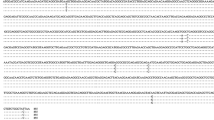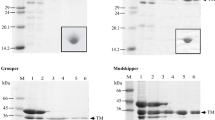Abstract
The invertebrate panallergen tropomyosin is a protein with an extremely simple folding. This makes it a perfect target for investigating structural differences between invertebrate and vertebrate tropomyosins, which are not considered allergenic. Phylogenetic and sequence analyses were conducted in order to explore the differences in primary structure between several tropomyosins and to promote an experimental development in the field of food allergy, based on the study of tropomyosin. The phylogenetic analyses showed that tropomyosin is a useful evolutionary marker. The phylogenetic trees obtained with tropomyosin were not always phylogenetically correct, but they might be useful for allergen avoidance by tropomyosin allergic individuals. Sequence analyses revealed that the probability of alpha helix folding in invertebrate tropomyosins was lower than in all the studied vertebrate ones, except for the Atlantic bluefin tuna Thunnus thynnus tropomyosin. This suggested that the lack of alpha helix folding may be involved in the immunogenicity of tropomyosins. More specifically, the regions adjacent to the positions 133–135 and 201 of the invertebrate tropomyosins, presented lower probability of alpha helix folding than those of vertebrates and are candidates to be responsible for their allergenicity.






Similar content being viewed by others
References
Taylor SL (2008) Molluscan shellfish allergy. Adv Food Nutr Res 54:139–177
Woo CK, Bahna SL (2011) Not all shellfish “allergy” is allergy! Clin Transl Allergy 1:3
Rico Díaz MA (2007) Estudio de la alergia al marisco en el área de sanitaria de A Coruña. Dissertation, Universidad de La Coruña
Daul CB, Slattery M, Reese G, Lehrer SB (1994) Identification of the major brown shrimp (Penaeus aztecus) allergen (Pen a 1) as the muscle protein tropomyosin. Int Arch Allergy Immunol 105:49–55
Shanti KN, Martin BM, Nagpal S, Metcalfe DD, Rao PV (1993) Identification of tropomyosin as the major shrimp allergen and characterization of its IgE-binding epitopes. J Immunol 151:5354–5363
Kunimoto A, Sisino T, Sakai K, Matsumoto T, Takahashi K, Yamashita H, Hiemori M, Tsuji H, Kimoto M (2009) Molecular cloning and allergenicity of Pen j 1, a major allergen of kuruma prawn, Penaeus japonicus. Biosci Biotechnol Biochem 73:840–848
Jenkins JA, Breiteneder H, Mills EN (2007) Evolutionary distance from human homologs reflects allergenicity of animal food proteins. J Allergy Clin Immunol 120:1399–1405
Santiago HC, Bennuru S, Boyd A, Eberhard M, Nutman TB (2011) Structural and immunologic cross-reactivity among filarial and mite tropomyosin: implications for the higiene hypothesis. J Allergy Clin Immunol 127:479–486
Liu R, Holck AL, Yang E, Liu C, Xue W (2013) Tropomyosin from tilapia (Oreochromis mossambicus) as an allergen. Clin Exp Allergy 43:365–377
Fitzsimmons CM, Dunne DW (2009) Survival of the fittest: allergology or parasitology? Trends Parasitol 25:447–451
Asturias JA, Eraso E, Moneo I, Martínez A (2000) Is tropomyosin an allergen in Anisakis? Allergy 55:898–899
Smillie LB (1979) Structure and functions of tropomyosins from muscle and non-muscle sources. Trends Biochem Sci 4:151–155
Sigrist CJ, Cerutti L, Hulo N, Gattiker A, Falquet L, Pagni M, Bairoch A, Bucher P (2002) PROSITE: a documented database using patterns and profiles as motif descriptors. Brief Bioinform 3:265–274
Asturias JA, Eraso E, Martínez A (2000) Cloning and high level expression in Escherichia coli of an Anisakis simplex tropomyosin isoform. Mol Biochem Parasitol 108:263–267
Jeong KY, Hong CS, Yong TS (2006) Allergenic tropomyosins and their cross-reactivities. Protein Pept Lett 13:835–845
Shanti KN, Martin BM, Nagpal S, Metcalfe DD, Rao PV (1993) Identification of tropomyosin as the major shrimp allergen and characterization of its IgE-binding epitopes. J Immunol 151:5354–5363
Reese G, Ayuso R, Carle T, Lehrer SB (1999) IgE-binding epitopes of shrimp tropomyosin, the major allergen Pen a 1. Int Arch Allergy Immunol 118:300–301
Reese G, Ayuso R, Lehrer SB (1999) Tropomyosin: an invertebrate pan-allergen. Int Arch Allergy Immunol 119:247–258
Ayuso R, Sanchez-García S, Pascal M, Lin J, Grishina G, Fu Z, Ibanez MD, Sastre J, Sampson HA (2012) Is epitope recognition of shrimp allergens useful to predict clinical reactivity? Clin Exp Allergy 42:293–304
Ayuso R, Sánchez-Garcia S, Lin J, Fu Z, Ibáñez MD, Carrillo T, Blanco C, Goldis M, Bardina L, Sastre J, Sampson HA (2010) Greater epitope recognition of shrimp allergens by children than by adults suggests that shrimp sensitization decreases with age. J Allergy Clin Immunol 125:1286–1293
Larkin MA, Blackshields G, Brown NP, Chenna R, McGettigan PA, McWilliam H, Valentin F, Wallace IM, Wilm A, Lopez R, Thompson JD, Gibson TJ, Higgins DG (2007) ClustalW and ClustalX version 2.0. Bioinformatics 23:2947–2948
Nicholas KB, Nicholas HB (1997) GeneDoc: a tool for editing and annotating multiple sequence alignments. Distributed by the author, http://www.nrbsc.org/downloads/
García-Boronat M, Diez-Rivero CM, Reinherz EL, Reche PA (2008) PVS: a web server for protein sequence variability analysis tuned to facilitate conserved epitope discovery. Nucleic Acids Res 36:35–41
Tamura K, Peterson D, Peterson N, Stecher G, Nei M, Kumar S (2011) MEGA5: Molecular Evolutionary Genetics Analysis using Maximum Likelihood, Evolutionary Distance, and Maximum Parsimony Methods. Mol Biol Evol 28:2731–2739
Guindon S, Dufayard JF, Lefort V, Anisimova M, Hordijk W, Gascuel O (2010) New algorithms and methods to estimate maximum-likelihood phylogenies: assessing the performance of PhyML 3.0. Syst Biology 59:307–321
Garnier J, Gibrat JF, Robson B (1996) GOR secondary structure prediction method version IV. Meth Enzymol 266:540–553
Combet C, Blanchet C, Geourjon C, Deléage G (2000) NPS@: Network Protein Sequence Analysis. TIBS 25:147–150
Felsenstein J (1985) Confidence limits on phylogenies: an approach using the bootstrap. Evolution 39:783–791
Zuckerkandl E, Pauling L (1965) Evolutionary divergence and convergence in proteins. In: Bryson V, Vogel HJ (eds) Evolving Genes and Proteins. Academic Press, New York, pp 97–166
Sneath PHA, Sokal RR (1973) Numerical Taxonomy. Freeman W H and Company, San Francisco
Saitou N, Nei M (1987) The neighbor-joining method: a new method for reconstructing phylogenetic trees. Mol Biol Evol 4:406–425
Rzhetsky A, Nei M (1992) A simple method for estimating and testing minimum evolution trees. Mol Biol Evol 9:945–967
Nei M, Kumar S (2000) Molecular Evolution and Phylogenetics. Oxford University Press, New York
Le SQ, Gascuel O (2008) An improved general amino acid replacement matrix. Mol Biol Evol 25:1307–1320
Gascuel O (1997) BIONJ: an improved version of the NJ algorithm based on a simple model of sequence data. Mol Biol Evol 14:685–695
Abascal F, Zardoya R, Posada D (2005) ProtTest: selection of best-fit models of protein evolution. Bioinformatics 21:2104–2105
Wang X, Li L, Xu F, Zhang G (2011) Tropomyosin is a nice marker gene for phylogenetic analysis of molluscs. Mol Biol Rep 38:4589–4593
Peña C (2011) Métodos de inferencia filogenética. Rev Peru Biol 18:265–267
FAO/WHO (2001) Evaluation of Allergenicity of Genetically Modified Foods. Report of a Joint FAO/WHO Expert Consultation on Allergenicity of Foods Derived from Biotechnology. FAO, Rome
FAO/WHO (2009) Guideline for the conduct of food safety assessment of foods derived from recombinant DNA plants. In WHO/FAO (ed) Codex Alimentarius Guidelines. Foods derived from modern biotechnology, 2nd edn. FAO, Rome pp 52–55
García BE, Lizaso MT (2011) Cross-reactivity syndromes in food allergy. J Investig Allergol Clin Immunol 21:162–170
Van Do T, Elsayed S, Florvaag E, Hordvik I, Endresen C (2005) Allergy to fish parvalbumins: studies on the cross-reactivity of allergens from 9 commonly consumed fish. J Allergy Clin Immunol 116:1314–1320
Tsabouri S, Triga M, Makris M, Kalogeromitros D, Church MK, Priftis KN (2012) Fish and shellfish allergy in children: review of a persistent food allergy. Pediatr Allergy Immunol 23:608–615
Fernandes J, Reshef A, Patton L, Ayuso R, Reese G, Lehrer SB (2003) Immunoglobulin E antibody reactivity to the major shrimp allergen, tropomyosin, in unexposed Orthodox Jews. Clin Exp Allergy 33:956–961
Ghosh D, Gupta-Bhattacharya S (2008) Structural insight into protein T1, the non-allergenic member of the Bet v 1 allergen family-An in silico analysis. Mol Immunol 45:456–462
Blair JE (2009) Animals (Metazoa). In: Hedges SB, Kumar S (eds) The Timetree of Life. Oxford University Press, Oxford, pp 223–230
Fitch WM, Margoliash E (1967) Construction of phylogenetic trees. Science 155:279–284
González-de-Olano D, Bartolomé B, Maroto AS, Vivanco F, Pastor-Vargas C (2012) Asthma after chicken consumption due to cross-reactivity between fish and chicken parvalbumin. J Investig Allergol Clin Immunol 22:227–228
Restani P, Ballabio C, Tripodi S, Fiocchi A (2009) Meat allergy. Curr Opin Allergy Clin Immunol 9:265–269
Greenfield NJ, Hitchcock-DeGregori SE (1995) The stability of tropomyosin, a two stranded coiled-coil protein, is primarily a function of the hydrophobicity of residues at the helix-helix interface. Biochemistry 34:16797–16805
Sumida JP, Wu E, Lehrer SS (2008) Conserved Asp-137 imparts flexibility to tropomyosin and affects function. J Biol Chem 283:6728–6734
Acknowledgments
The present study was supported by the Ramón Areces Foundation. JGF is supported by a PhD fellowship from Universidad Complutense de Madrid. We thank José Castresana for useful comments and three anonymous reviewers that helped improve the manuscript.
Author information
Authors and Affiliations
Corresponding author
Rights and permissions
About this article
Cite this article
González-Fernández, J., Rodero, M., Daschner, A. et al. New insights into the allergenicity of tropomyosin: a bioinformatics approach. Mol Biol Rep 41, 6509–6517 (2014). https://doi.org/10.1007/s11033-014-3534-6
Received:
Accepted:
Published:
Issue Date:
DOI: https://doi.org/10.1007/s11033-014-3534-6




